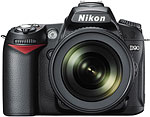 First Nikon D90 test shots posted!
First Nikon D90 test shots posted!
By
Dave Etchells
(Wednesday, August 27, 2008 - 22:04 EDT)
Exclusive! We have a production-level sample of the D90, and have posted the first batch of tests shots we captured with it.
We just got our hands on a production-level sample of the new Nikon D90,and have begun running it through our laboratory tests. The first batch of test images are online now, in our Nikon D90 Preview, which we've just updated to First Shots status. Stay tuned, we'll have more test shots tomorrow, and hopefully some timing data on the new camera by Friday!
We haven't done any formal analysis on the images yet, they're just listed in a thumbnails page. Many of the file names should be pretty self-explanatory though: Look for "NR" in file names to see the impact of various levels of high-ISO Noise Reduction. Explicitly labeled shots have NR levels of low, high, or off. Shots without NR labels were captured with the high-ISO NR set to its default "Normal" value. Default minimum ISO is 200, the ISO 100 shots were captured at the "L1.0" setting. Likewise, default maximum ISO is 3,200, the shots at 6,400 ISO were captured using the "H1.0" setting. Other series you'll see are: CON - Contrast; SAT - Saturation; BRT - "Brightness"; DLITE - Active D-Lighting, and PICT - the various Picture Control options, with their default "tweak" settings.
Note that we've shot a number of NEF RAW files as well, you'll find links to these wherever there's a NEF that corresponds to one of the JPEGS. (Be gentle with our bandwidth, these are big files!) We checked, DCraw will open these NEFs, albeit with incorrect white balance. Hopefully, the early availability of these NEF files will help developers of third-party RAW converters quickly write code to read the D90's images.
Eagle-eye IR staffer Zig noticed that the D90 images were showing very low levels of chromatic aberration: Could this be the same sort of CA-correction that the D3 and D300 provide? Checking the NEF files in DCraw seems to suggest that it is, as there appears to be more CA visible in the NEF files than in the associated JPEGs. A pretty significant feature that we haven't seen mentioned anywhere, and that we didn't hear about from Nikon either. Cool! (Tell your friends, you heard it here first!)
|